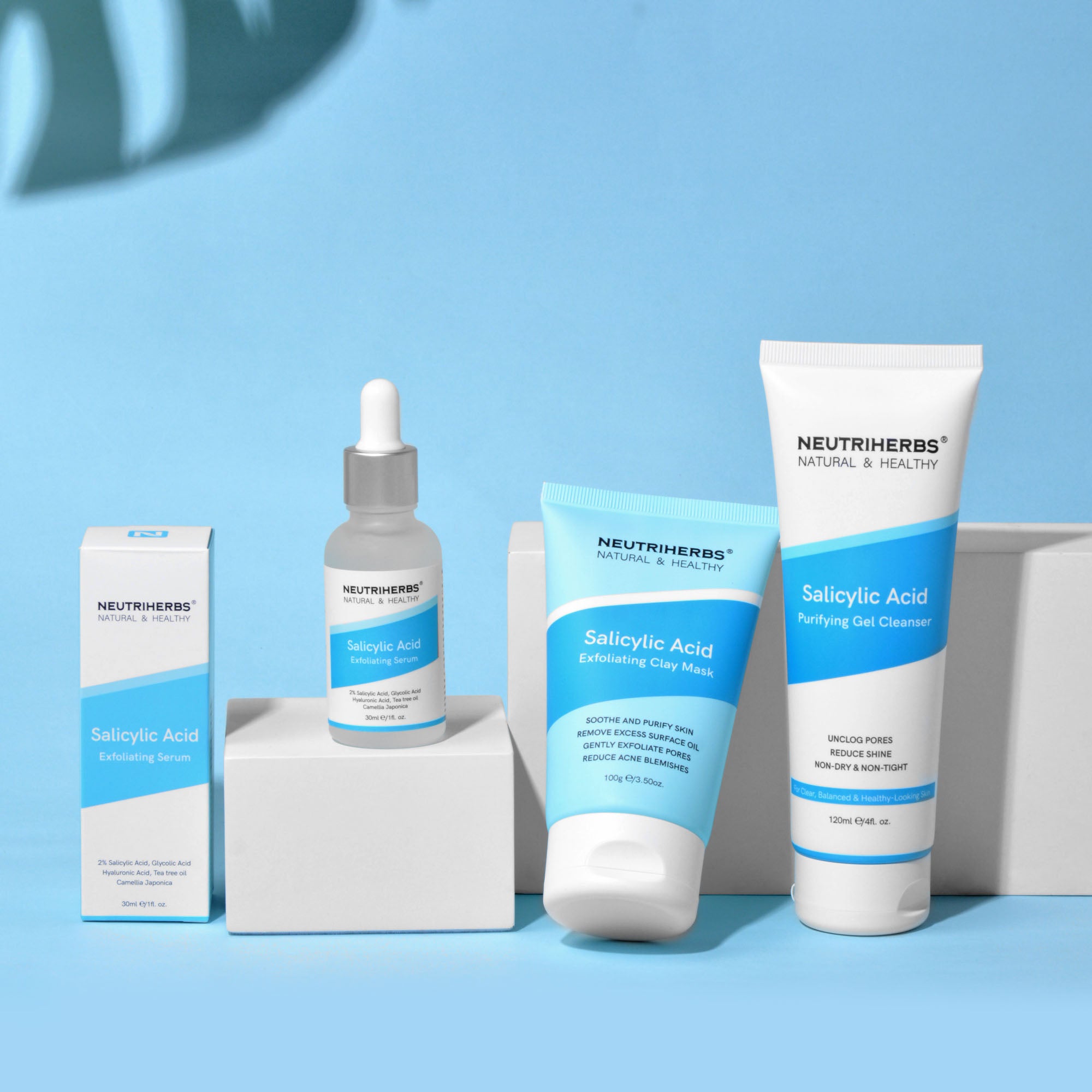
We know your little secret. You’ve done a lot of crazy stuffs like bursting or using toothpaste on your pimples and even hiding them with makeup in hopes of dealing with acne.
But let’s admit it - None of that works and the smartest way to treat acne is by being patient and using the right skincare ingredients.
Ask any dermatologists and they’ll tell you: Salicylic acid is a tried-and-true ingredient for getting rid of blackheads, whiteheads, and excess oil—and keeping them gone.
If acne has ever dealt with you, then chances are you probably must have already heard about how salicylic acid can transform your skin. It has an impressive 673,000 monthly search on Google which shows how popular and useful a solution it could be for acne due to it’s exfoliating and bacteria fighting abilities.
But because acne is a very complex and broad issue, some solutions are more suitable for certain types of acne than others.
So to find out if salicylic acid will work for you, your skin type, or your type of acne, you first have to understand how it works and how to use it.
Here’s everything you need to know about what makes this ingredient so impressive and how salicylic acid contributes to clear skin.

What Is Salicylic Acid?
When it comes to exfoliating acids, you've got a few options to choose from based on what your skin needs.
Salicylic acid, Is an ingredient naturally extracted from willow tree bark, it belongs to a class of ingredients known as salicylates (is one type of chemical exfoliant called beta-hydroxy acid aka BHA).
How Does Salicylic acid work
Before explaining exactly how salicylic works, here's a quick refresher on how breakouts form: when bacteria, debris, sebum, and dead skin cells mix together, a clog forms inside your pores.
Unlike the chemical exfoliants called alpha-hydroxy acids (AHAs), which are water-soluble and works well on the skin’s surface to loosen old, dead skin to reveal fresh newer skin, salicylic is oil-soluble which gives it a unique ability to penetrate through oil and exfoliate deep within your pores to remove blockages.
So by increasing the amount of moisture in the skin, the blockages are softened so much that the substance that causes the skin cells to stick together dissolves. This makes it easier to shed the dead skin cells and maintain clear pores. This unique working mechanism of salicylic acid is why it’s a cult favorite skincare product for those with oily, acne-prone skin.
Salicylic acid as an ingredient can be found in many forms in a skincare product, like cleansers, toners, serums, and masks, which can all be beneficial to the skin in their own right. Each vehicle uses salicylic acid in its own special way and is targeted for certain use in specific people, depending on their skin issues.
Benefits of Salicylic Acid For Skin:
Thanks to its deep exfoliating and bacteria fighting properties, salicylic acid is used to treat a range of skin conditions outside of acne, from warts to dandruff.
Here's a breakdown of exactly how salicylic acid works to benefit the skin:
Exfoliates dead skin
As a keratolytic (ingredient that breaks down outer layers of skin), salicylic acid encourages cellular turnover and helps to slough off dead skin cells, which in turn can improve skin dullness and texture.
Softens the contents of clogged pores
The oil-soluble ingredient is able to penetrate super deep into the pores, loosen the "glue" that causes the skin cells to stick together and remove the contents of clogged pores that lead to surface acne, like whiteheads, blackheads, and small red pimples.
Removes excess oil
Salicylic acid is oil-soluble, it can penetrate beneath the skin’s surface to clean out excess sebum from the pores and reduce excess oil. This can, in turn, also lead to an improvement in the appearance of pores.
Prevents whiteheads and blackheads
There are three factors that contribute to acne: an abnormal sloughing off of skin cells, excessive oiliness, and the action of P. acnes bacteria. Salicylic acid helps with the first cause by dissolving the type of skin debris that clogs pores and causes acne.
Which makes it ideal for treating blackheads and whiteheads by directly dissolve the keratin plugs and regulating the skin cells. Not only does salicylic acid treat existing breakouts, whiteheads and blackheads, it prevents them from returning to the surface level of your skin.
Combats acne
Because it is lipophilic (ingredient that dissolves in oil), salicylic acid can penetrate deep into pores to prevent acne from forming in the future.
Minimizes pores
As an astringent product, salicylic acid can tighten the skin, thereby reducing the appearance of pores.
Reduces inflammation
Salicylic acid belongs to the same class of drugs as aspirin (salicylates). Because of salicylic acid's anti-inflammatory properties, it helps to address irritation, redness related to breakouts and inflamed pimples and pustules go away faster.
Fades acne scars
Salicylic acid has the ability to break up old skin cells and encourage new skin cells to form, which, in turn, helps lighten dark spots and marks left by old pimples. And thanks to the anti-inflammatory abilities of salicylic acid, regular use can also help prevent those dark marks from happening in the first place.
Is Salicylic Acid Better Than Benzoyl Peroxide?
It depends on the acne you’re dealing with and which your skin type can handle.
They both take different approaches when targeting breakouts. While salicylic acid does an excellent job of treating whiteheads and blackheads by dissolving dead skin and unclogging pores, benzoyl peroxide is an antibacterial ingredient that kills acne-causing bacteria that leads to those swollen, red, pus-filled pimples.
Benzoyl peroxide is also less suitable for sensitive skin than salicylic acid, as it’s drying properties can cause flaky irritated skin.
Although they both can be used together for more power. But not same time or routine. So try using them on alternate nights or using salicylic acid in the morning and benzoyl peroxide at night.
Still, if blackheads and whiteheads are your main concern, you should definitely consider trying a salicylic acid cleanser, serum, mask or spot treatment.
Side Effects of Salicylic Acid
Salicylic acid is best suited for those with oily skin and surface acne. For those with dry, eczema-prone, or sensitive skin, the drying ingredient could be too harsh and lead to irritation so you want to use something as soothing and nourishing as a Hemp seed oil serum or Hemp seed oil cream.
Possible side effects of salicylic acid include dry, burning, and overall irritated skin in the areas of application but these effects are more commonly experienced at the start of treatment and stops once skin adjusts.
More also, salicylic acid can make your skin more sensitive to sunlight and cause sunburn easily.
Although you should always protect your skin from the sun, it's especially important when using salicylic acid to limit your sun exposure as much as possible and always use and reapply a non-greasy sunscreen.
However, the concentration of Neutriherbs salicylic acid Products is low at 2%. Which means it can be well tolerated by all skin types including dry and sensitive ones.
How to Use Salicylic Acid
When starting a new salicylic acid based product use in moderation until you know your skin can tolerate it. Start off slowly applying it every other day (and then work your way up to daily use once your skin gets used to it), and take note of how your skin reacts after each application. The key is to listen to your skin. If it's getting irritated, you'll need to take a day or two off and perhaps be a bit more vigilant with moisturizing.
It’s perfectly fine to use every day especially if you have oily skin but first start with using on alternate days then increase frequency once you are certain your skin can handle it.
How long does it take for salicylic acid to work?
You can feel some instant benefits after using salicylic acid like less oiliness. You’ll likely see major results in four to six weeks after which you should continue to use it for long-term effects that peaks after 12 weeks. That means you shouldn’t expect any miracles overnight — Clear skin requires patience. If you want to give salicylic acid a fair shot, stick with it for at least a month before you start thinking next steps.
The Best Products With Salicylic Acid

Neutriherbs Salicylic Acid Purifying Gel Cleanser - 120ml (N5,500)
If you have oily skin and you're looking for a budget-friendly option, you will love love and love this purifying cleanser, which uses 2 percent salicylic acid to wash away dead skin cells. Dealing with back acne? You can also use this face wash as a cleanser for pesky body breakouts.

Neutriherbs Salicylic Acid Exfoliating Serum - 30ml (N8,800)
This BHA exfoliating serum might look simple, but it's super effective. It relies on 2 percent salicylic acid combined with Glycolic acid, tea tree oil and soothing camellia japonica to treat a number of skin concerns, like irritation, dullness, wrinkles, and acne. Not only is it one of Neutriherb's Newly launched serums, it's also on it’s way to becoming a top-selling Customer’s favorite. Are you sold yet?

Neutriherbs Salicylic Acid Clay Mask - 100g (N7500)
Try Neutriherbs Saliclylic acid exfoliating clay mask made with Niacinamide, allantoin and a combination of AHA and BHAs. It works to soothe and purify skin, remove excess oil, gently exfoliate pores and reduce acne blemishes.
The Bottom line:
If you’re looking to clear up blackheads and whiteheads, you should absolutely try working salicylic acid into your skincare routine (your skin needs it). Remember: Start low and slow—i.e., don’t slather it on every day—to avoid any irritation or dryness, and expect to see results in a month or so. Sounds like a lot, but trust us: Salicylic acid is an acne game changer that’s worth a try.


